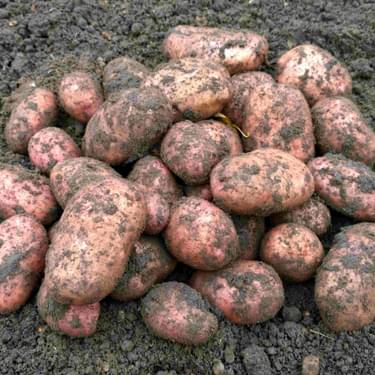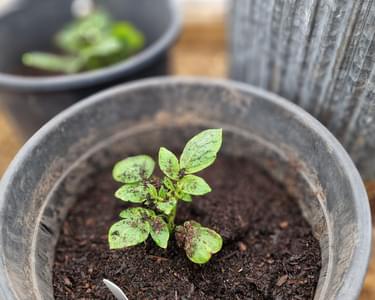
Potatoes
- Potato | Growing Guides
- Tags
- Growing Guides Vegetables and herbs
| Growing calendar | |
|---|---|
| Chit indoors | January |
| Plant out/transplant | March - April |
| Harvest | Earlies/salad: May/June. Maincrop: July/October |
You may also like

Potatoes come in an enormous selection of shapes, sizes, colours and cooking/eating qualities, as well as resistance to common potato pests and diseases. It's worth trying a range of varieties to see which best suits your garden, soil and taste.
Seed potatoes
Potatoes are grown from seed tubers that are certified free from virus and disease and are known as ‘seed potatoes’. It's important to always buy fresh, preferable organic seed potatoes each year. Don't be tempted to plant sprouted tubers from the kitchen as these are not certified and may introduce potato viruses and diseases to your garden. Tubers are available in late winter/early spring. They need to be stored in a cool dark place prior to chitting and planting out in March or April.
How to chit potatoes
Chitting is the name for the process that encourages tubers to sprout before planting. Contrary to popular belief, chitting potatoes is not essential except for early varieties to produce an earlier maturing crop. If you buy tubers that have already started sprouting it is best to chit them straight away. If they haven't sprouted, they can be left in a cool dark place until you're ready.
To chit seed potatoes, place them side-by-side in a clean egg box or tray, ‘rose end’ up (the end where tiny buds can be seen). Label the box with the potato variety and put in a cool light place for four to six weeks allowing the chits to develop.
Preparing your soil
Potatoes grow best in a rich, fertile soil with plenty of organic matter incorporated. Ideally, soil pH should be around 6.5 or lower. In spring, dig homemade compost into the top 30cm of soil. It's best to follow a crop rotation plan with potatoes, and not plant them in the same ground with less than a four year gap from the previous crop. This helps to avoid a build up of diseases such as blight.
Planting potatoes
The planting date for potatoes will vary from year-to-year and around the country. The soil temperature should be at least 6C (43F). A good indication of this is when grass and weeds begin to grow. This is usually in March/April, but it could be later for north and east areas.
Place the tubers rose end up in the bottom of holes or trenches that are 15cm deep. The shoots and leaves of potatoes are frost tender, so 'earth up' the stems by drawing soil around them. See 'General Care' below.
Earlies/salad: Plant mid- to late March.
Second earlies: Plant early to mid-April.
Maincrop: Plant mid- to late April.
Earlies/second earlies can be planted around 30cm apart, in rows 50-60cm apart. Maincrops are planted 40cm apart in rows 70cm apart.
You can also try a no-dig method of shallow planting and covering with a thick layer of organic matter on the top. Potatoes are then harvested by pulling them out of the mulch.
Potatoes can also grown in pots.
General care
Potatoes can be earthed up as they grow, this involves bringing soil up around the shoots to make a ridge. It helps control weeds, prevents the tubers turning green and gives some protection against blight. Do it first when plants are around 15cm tall, leaving about 5cm of foliage showing. Earth up again just before the foliage meets across the rows.
Plants can be mulched with a layer of hay, straw, leafmould or grass clippings. This will have the added benefit of conserving moisture. On a closer spacing, earthing up will not be possible, but the shade the plants provide each other will have the same effect.
Potato blight is a common problem during warm wet weather, read more about potato blight here.
Harvesting and storing potatoes
Early varieties: Will be ready from June to July, around nine to ten weeks after planting. Flowering is usually a good indicator that the tubers have reached an edible size, but not all varieties produce flowers. Dig up one plant or investigate with a trowel to see if the tubers are ready. They are best harvested as needed, leaving the rest to grow on. Most early varieties are not suitable for long-term storage.
Maincrop varieties: Depending on the variety, planting date and the growing conditions, these will be ready from August through to early October. Mature tubers with well-developed skins store best, so ideally they should be left in the ground for two to three weeks after the haulms have died back. Dig the crop carefully to avoid damage, on a sunny day if possible. Leave the potatoes to dry for a couple of hours on the soil surface before bagging up. If the crop is damaged by pests, lift earlier.
| Growing notes | |
|---|---|
| Difficulty | Easy |
| Average time to harvest | From nine weeks |
Take a look at our other growing guides
-

Carrot
These crunchy, nutritious root vegetables are one of our most versatile staples. They can be grown in pots or in the ground, and come in an array of colours.
-
Parsnip
Discover how to grow parsnips successfully with our expert gardening guide. Learn essential tips and techniques for cultivating these nutritious root vegetables in your own backyard.
-

Turnip
These pink-tinged fleshy root vegetables are easy to grow and a good source of vitamin C. Pick when they're babies for a sweeter flavour. The leaves can also be used as greens.
